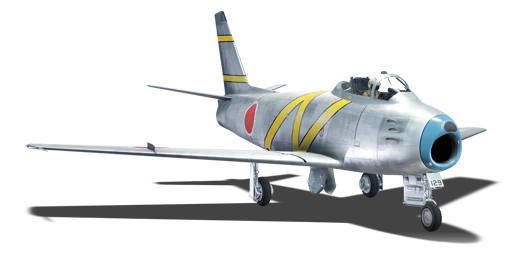



The F-86F-30 ("NA-191" as North American called it) was the first Sabre to be built with bombing in mind. Earlier Sabres had pitiful endurance when carrying bombs, which became an issue. This led to North American designing the NA-191, which had four hardpoints, either for more fuel or bombs. The combat range was greatly increased, which remedied the main issue of the Sabre's role as a fighter-bomber. The F-86F-30 would soon find a home in Japan. Although Japan was not allowed to have an air force after the war, Allied nations eased up on the restriction and allowed the Japan Air Self Defence Force in 1953. A year later, after the air force was established, they picked the F-86F to be their main fighter. 29 F-86F-25/30s were brought in from US surplus. Many early F-86Fs were brought up to the F-40 standard, which featured improved handling with leading-edge slats.
Introduced in Update 1.39, the F-86F-30 (Japan) is a fairly good fighter. Thanks to its sleek design and swept-wings, the F-86F-30 can reach speeds in excess of 1,100 km/h (683 mph). However, the J47 engine has relatively low thrust output, and it takes time to reach significant speeds. One of the main advantages of the F-86 Sabre is its impressive roll rate. Many aircraft at its battle rating will not be able to compete with it, especially MiG-15s. The F-86F-30 has the standard armament of six nose-mounted 12.7 mm M3 Browning machine guns, which have significant range but lack stopping power. This is one of the few downsides of the Sabre, but it is compensated for by the large ammunition pool. Overall, the F-86F-30 (Japan) is a powerful aircraft that can also be used as a fighter-bomber.
flaps
flaps
flaps
brake
| Belt | Belt filling | Armor penetration (mm) at a distance: | |||||
|---|---|---|---|---|---|---|---|
| 10 m | 100 m | 500 m | 1000 m | 1500 m | 2000 m | ||
| API-T/AP/AP/I | 30 | 27 | 20 | 13 | 9 | 6 | |
| AP-I/AP-I/API-T/I/I | 28 | 26 | 18 | 11 | 7 | 4 | |
| API-T/I/AP/AP/AP-I/AP-I | 30 | 27 | 20 | 13 | 9 | 6 | |
| API-T | 28 | 26 | 18 | 11 | 7 | 4 | |
| AP-I/I/AP-I/I | 28 | 26 | 18 | 11 | 7 | 4 | |
8 × HVAR rockets












Flight performance | |
|---|---|
Survivability |
|---|
Weaponry | |
|---|---|